Partnership Working in Health and Social Care: Analysis Report
VerifiedAdded on 2024/07/01
|26
|5289
|351
Report
AI Summary
This report provides a comprehensive analysis of partnership working within the health and social care sector. It begins by explaining the philosophy behind partnership, emphasizing empowerment, independence, respect, informed choices, and autonomy, referencing the Francis Report on the NHS Foundation Trust. The report evaluates partnership relationships among professionals, service users, and organizations, highlighting the importance of communication and trust. It then analyzes different models of partnership working, including networking, referral systems, consortium, and multi-agency models, and discusses relevant legislation like the Mental Capacity Act 2005. Further, the report examines the potential outcomes and barriers to partnership working, such as poor communication and lack of resources, and suggests strategies for improvement. The overall aim is to enhance the understanding and effectiveness of partnership working to improve service quality and patient well-being within health and social care.

Paraphrase This Document
Need a fresh take? Get an instant paraphrase of this document with our AI Paraphraser
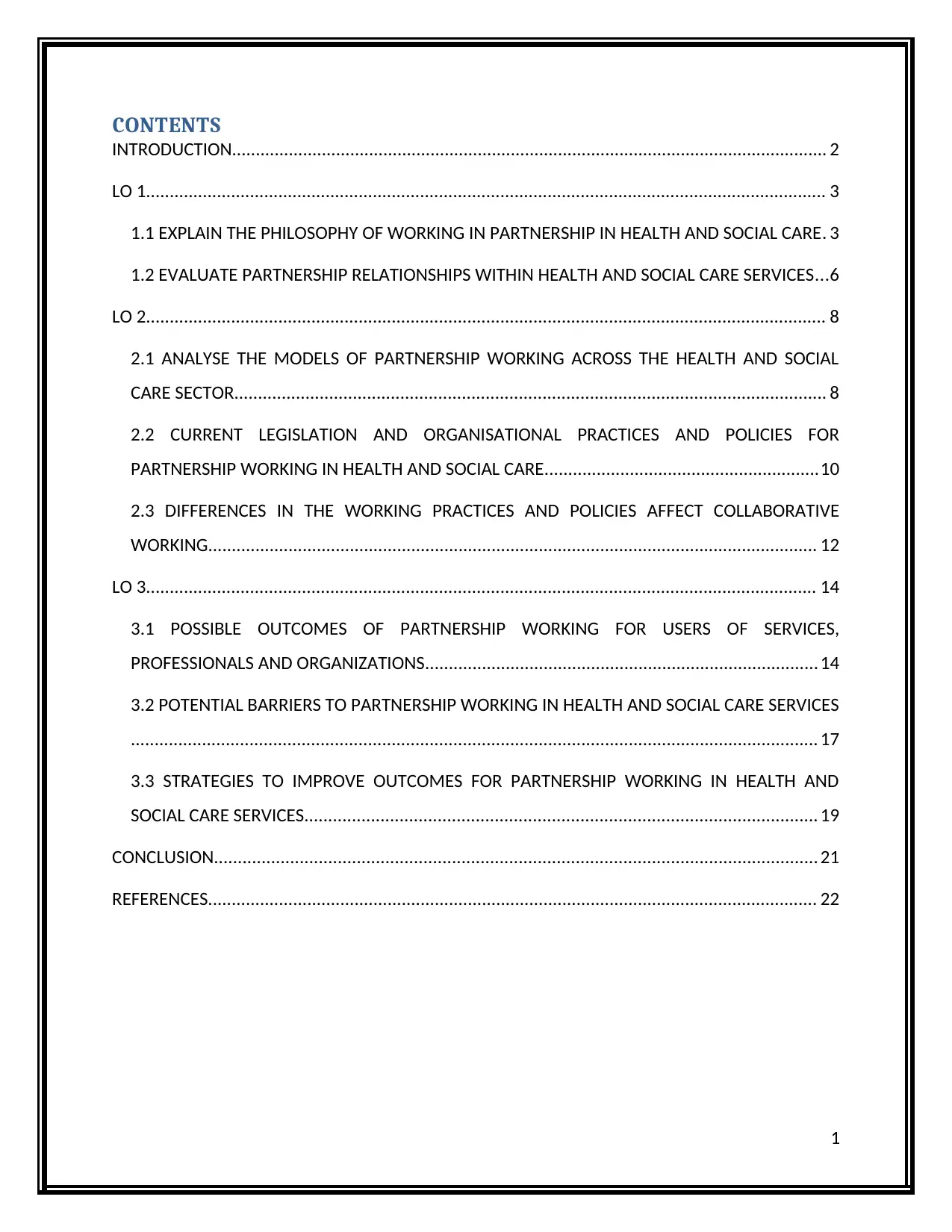
CONTENTS
INTRODUCTION.............................................................................................................................. 2
LO 1................................................................................................................................................ 3
1.1 EXPLAIN THE PHILOSOPHY OF WORKING IN PARTNERSHIP IN HEALTH AND SOCIAL CARE. 3
1.2 EVALUATE PARTNERSHIP RELATIONSHIPS WITHIN HEALTH AND SOCIAL CARE SERVICES...6
LO 2................................................................................................................................................ 8
2.1 ANALYSE THE MODELS OF PARTNERSHIP WORKING ACROSS THE HEALTH AND SOCIAL
CARE SECTOR............................................................................................................................. 8
2.2 CURRENT LEGISLATION AND ORGANISATIONAL PRACTICES AND POLICIES FOR
PARTNERSHIP WORKING IN HEALTH AND SOCIAL CARE..........................................................10
2.3 DIFFERENCES IN THE WORKING PRACTICES AND POLICIES AFFECT COLLABORATIVE
WORKING................................................................................................................................. 12
LO 3.............................................................................................................................................. 14
3.1 POSSIBLE OUTCOMES OF PARTNERSHIP WORKING FOR USERS OF SERVICES,
PROFESSIONALS AND ORGANIZATIONS................................................................................... 14
3.2 POTENTIAL BARRIERS TO PARTNERSHIP WORKING IN HEALTH AND SOCIAL CARE SERVICES
................................................................................................................................................. 17
3.3 STRATEGIES TO IMPROVE OUTCOMES FOR PARTNERSHIP WORKING IN HEALTH AND
SOCIAL CARE SERVICES............................................................................................................ 19
CONCLUSION............................................................................................................................... 21
REFERENCES................................................................................................................................. 22
1
INTRODUCTION.............................................................................................................................. 2
LO 1................................................................................................................................................ 3
1.1 EXPLAIN THE PHILOSOPHY OF WORKING IN PARTNERSHIP IN HEALTH AND SOCIAL CARE. 3
1.2 EVALUATE PARTNERSHIP RELATIONSHIPS WITHIN HEALTH AND SOCIAL CARE SERVICES...6
LO 2................................................................................................................................................ 8
2.1 ANALYSE THE MODELS OF PARTNERSHIP WORKING ACROSS THE HEALTH AND SOCIAL
CARE SECTOR............................................................................................................................. 8
2.2 CURRENT LEGISLATION AND ORGANISATIONAL PRACTICES AND POLICIES FOR
PARTNERSHIP WORKING IN HEALTH AND SOCIAL CARE..........................................................10
2.3 DIFFERENCES IN THE WORKING PRACTICES AND POLICIES AFFECT COLLABORATIVE
WORKING................................................................................................................................. 12
LO 3.............................................................................................................................................. 14
3.1 POSSIBLE OUTCOMES OF PARTNERSHIP WORKING FOR USERS OF SERVICES,
PROFESSIONALS AND ORGANIZATIONS................................................................................... 14
3.2 POTENTIAL BARRIERS TO PARTNERSHIP WORKING IN HEALTH AND SOCIAL CARE SERVICES
................................................................................................................................................. 17
3.3 STRATEGIES TO IMPROVE OUTCOMES FOR PARTNERSHIP WORKING IN HEALTH AND
SOCIAL CARE SERVICES............................................................................................................ 19
CONCLUSION............................................................................................................................... 21
REFERENCES................................................................................................................................. 22
1
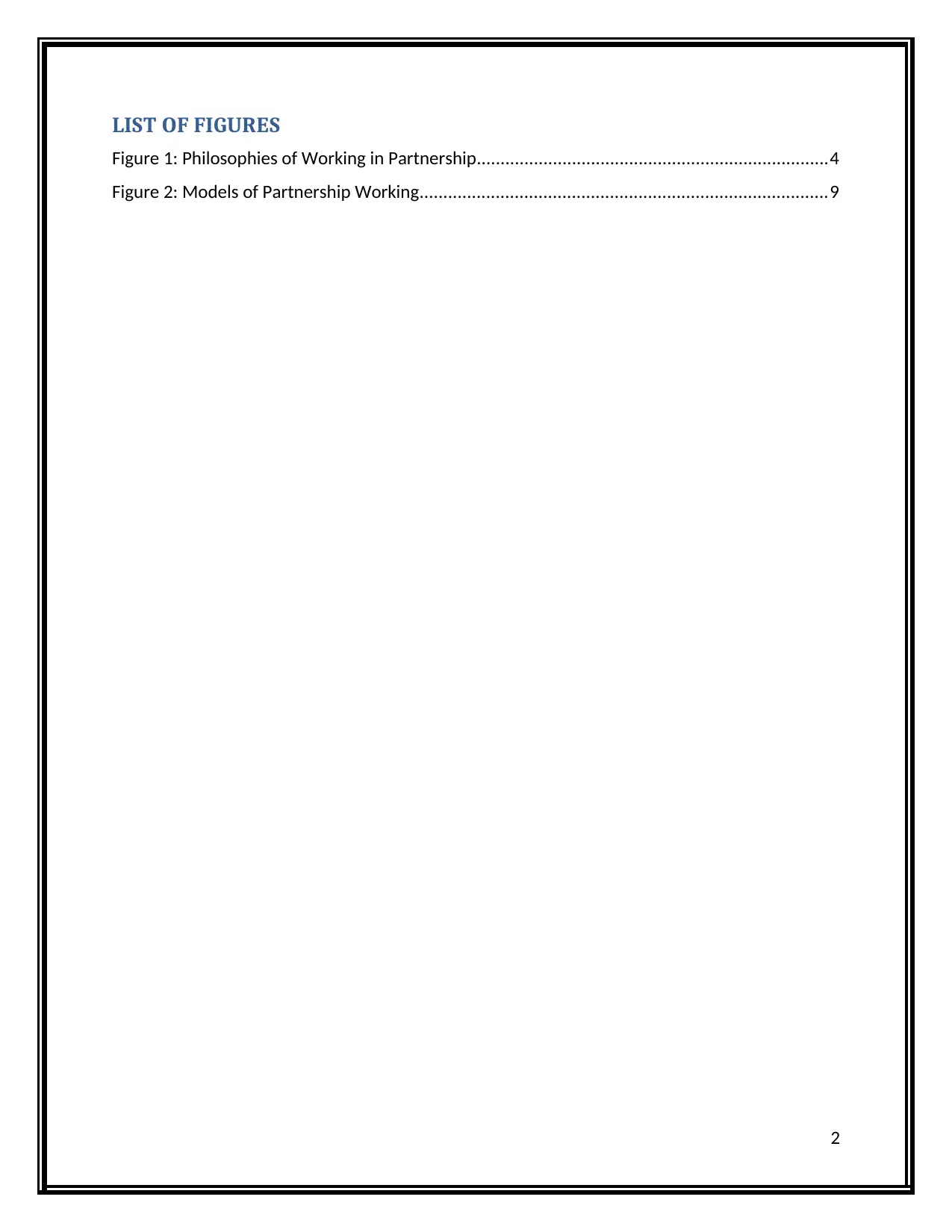
LIST OF FIGURES
Figure 1: Philosophies of Working in Partnership..........................................................................4
Figure 2: Models of Partnership Working......................................................................................9
2
Figure 1: Philosophies of Working in Partnership..........................................................................4
Figure 2: Models of Partnership Working......................................................................................9
2
⊘ This is a preview!⊘
Do you want full access?
Subscribe today to unlock all pages.

Trusted by 1+ million students worldwide
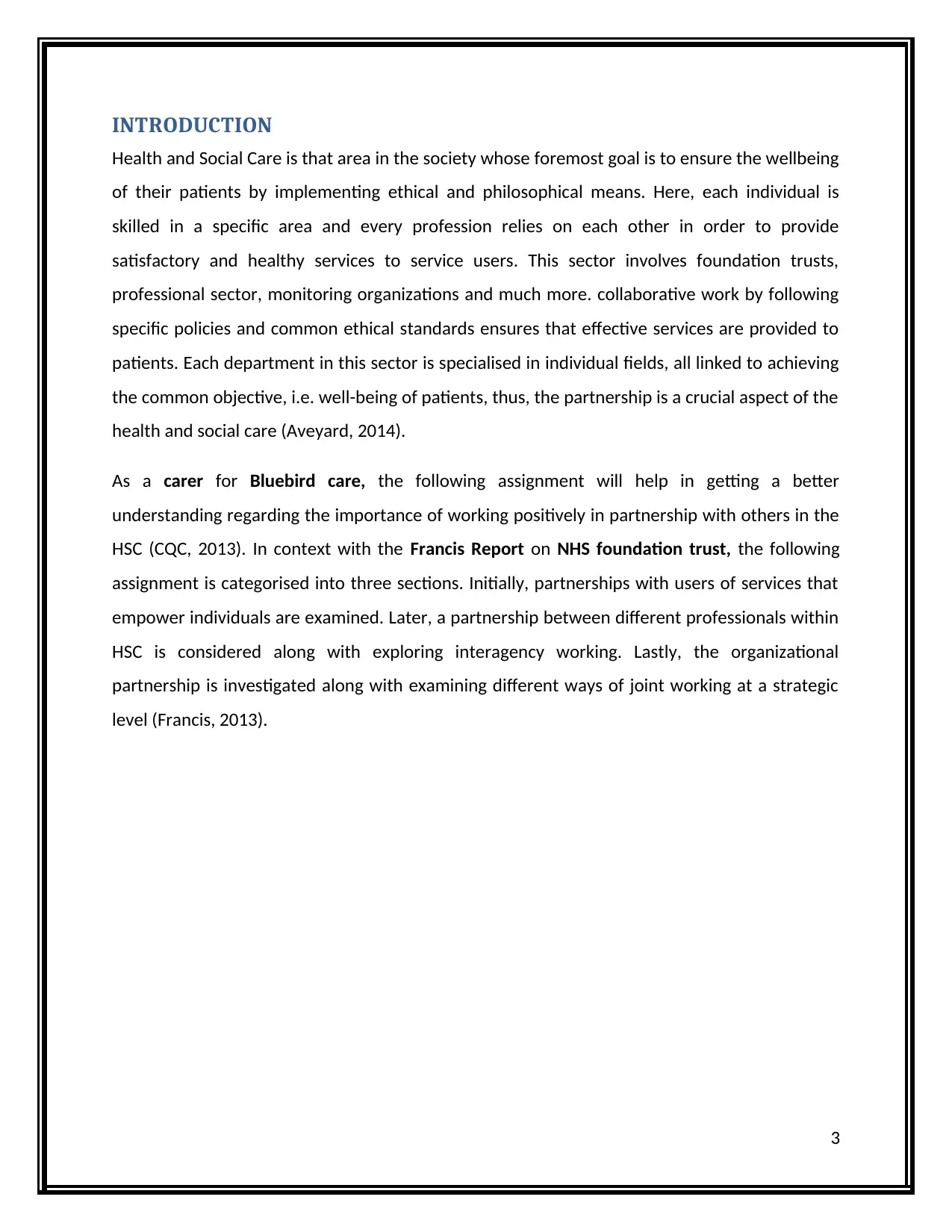
INTRODUCTION
Health and Social Care is that area in the society whose foremost goal is to ensure the wellbeing
of their patients by implementing ethical and philosophical means. Here, each individual is
skilled in a specific area and every profession relies on each other in order to provide
satisfactory and healthy services to service users. This sector involves foundation trusts,
professional sector, monitoring organizations and much more. collaborative work by following
specific policies and common ethical standards ensures that effective services are provided to
patients. Each department in this sector is specialised in individual fields, all linked to achieving
the common objective, i.e. well-being of patients, thus, the partnership is a crucial aspect of the
health and social care (Aveyard, 2014).
As a carer for Bluebird care, the following assignment will help in getting a better
understanding regarding the importance of working positively in partnership with others in the
HSC (CQC, 2013). In context with the Francis Report on NHS foundation trust, the following
assignment is categorised into three sections. Initially, partnerships with users of services that
empower individuals are examined. Later, a partnership between different professionals within
HSC is considered along with exploring interagency working. Lastly, the organizational
partnership is investigated along with examining different ways of joint working at a strategic
level (Francis, 2013).
3
Health and Social Care is that area in the society whose foremost goal is to ensure the wellbeing
of their patients by implementing ethical and philosophical means. Here, each individual is
skilled in a specific area and every profession relies on each other in order to provide
satisfactory and healthy services to service users. This sector involves foundation trusts,
professional sector, monitoring organizations and much more. collaborative work by following
specific policies and common ethical standards ensures that effective services are provided to
patients. Each department in this sector is specialised in individual fields, all linked to achieving
the common objective, i.e. well-being of patients, thus, the partnership is a crucial aspect of the
health and social care (Aveyard, 2014).
As a carer for Bluebird care, the following assignment will help in getting a better
understanding regarding the importance of working positively in partnership with others in the
HSC (CQC, 2013). In context with the Francis Report on NHS foundation trust, the following
assignment is categorised into three sections. Initially, partnerships with users of services that
empower individuals are examined. Later, a partnership between different professionals within
HSC is considered along with exploring interagency working. Lastly, the organizational
partnership is investigated along with examining different ways of joint working at a strategic
level (Francis, 2013).
3
Paraphrase This Document
Need a fresh take? Get an instant paraphrase of this document with our AI Paraphraser
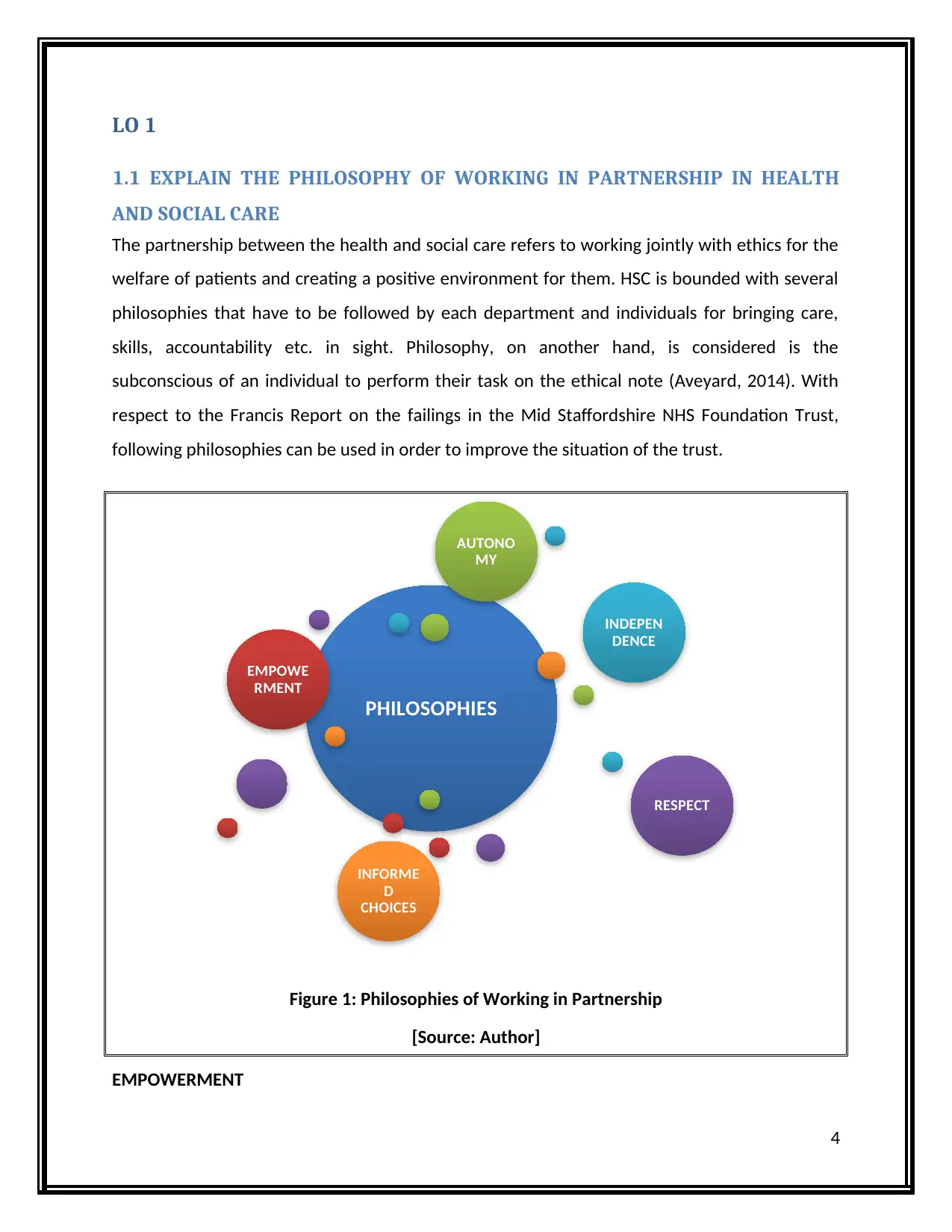
LO 1
1.1 EXPLAIN THE PHILOSOPHY OF WORKING IN PARTNERSHIP IN HEALTH
AND SOCIAL CARE
The partnership between the health and social care refers to working jointly with ethics for the
welfare of patients and creating a positive environment for them. HSC is bounded with several
philosophies that have to be followed by each department and individuals for bringing care,
skills, accountability etc. in sight. Philosophy, on another hand, is considered is the
subconscious of an individual to perform their task on the ethical note (Aveyard, 2014). With
respect to the Francis Report on the failings in the Mid Staffordshire NHS Foundation Trust,
following philosophies can be used in order to improve the situation of the trust.
Figure 1: Philosophies of Working in Partnership
[Source: Author]
EMPOWERMENT
4
PHILOSOPHIES
EMPOWE
RMENT
INDEPEN
DENCE
RESPECT
INFORME
D
CHOICES
AUTONO
MY
1.1 EXPLAIN THE PHILOSOPHY OF WORKING IN PARTNERSHIP IN HEALTH
AND SOCIAL CARE
The partnership between the health and social care refers to working jointly with ethics for the
welfare of patients and creating a positive environment for them. HSC is bounded with several
philosophies that have to be followed by each department and individuals for bringing care,
skills, accountability etc. in sight. Philosophy, on another hand, is considered is the
subconscious of an individual to perform their task on the ethical note (Aveyard, 2014). With
respect to the Francis Report on the failings in the Mid Staffordshire NHS Foundation Trust,
following philosophies can be used in order to improve the situation of the trust.
Figure 1: Philosophies of Working in Partnership
[Source: Author]
EMPOWERMENT
4
PHILOSOPHIES
EMPOWE
RMENT
INDEPEN
DENCE
RESPECT
INFORME
D
CHOICES
AUTONO
MY
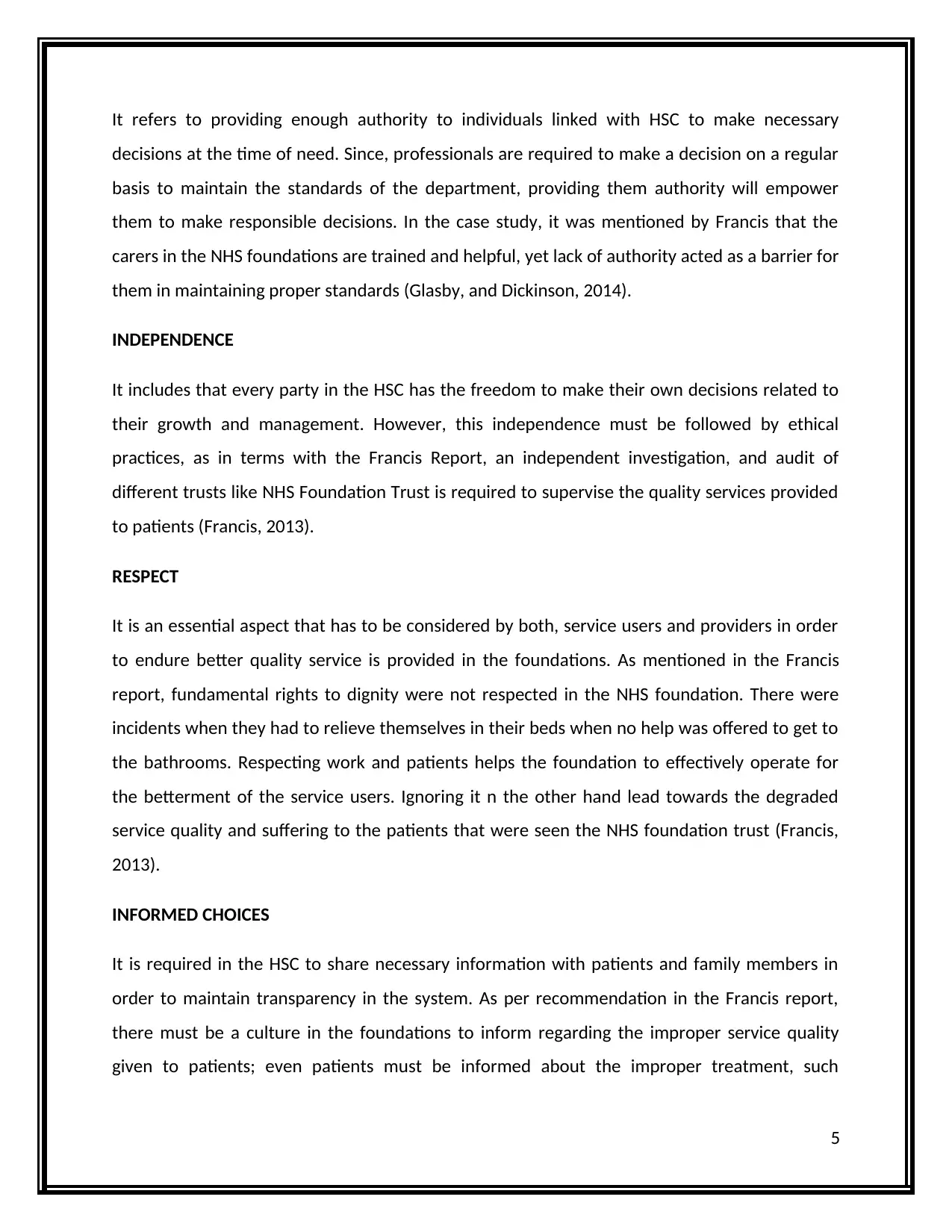
It refers to providing enough authority to individuals linked with HSC to make necessary
decisions at the time of need. Since, professionals are required to make a decision on a regular
basis to maintain the standards of the department, providing them authority will empower
them to make responsible decisions. In the case study, it was mentioned by Francis that the
carers in the NHS foundations are trained and helpful, yet lack of authority acted as a barrier for
them in maintaining proper standards (Glasby, and Dickinson, 2014).
INDEPENDENCE
It includes that every party in the HSC has the freedom to make their own decisions related to
their growth and management. However, this independence must be followed by ethical
practices, as in terms with the Francis Report, an independent investigation, and audit of
different trusts like NHS Foundation Trust is required to supervise the quality services provided
to patients (Francis, 2013).
RESPECT
It is an essential aspect that has to be considered by both, service users and providers in order
to endure better quality service is provided in the foundations. As mentioned in the Francis
report, fundamental rights to dignity were not respected in the NHS foundation. There were
incidents when they had to relieve themselves in their beds when no help was offered to get to
the bathrooms. Respecting work and patients helps the foundation to effectively operate for
the betterment of the service users. Ignoring it n the other hand lead towards the degraded
service quality and suffering to the patients that were seen the NHS foundation trust (Francis,
2013).
INFORMED CHOICES
It is required in the HSC to share necessary information with patients and family members in
order to maintain transparency in the system. As per recommendation in the Francis report,
there must be a culture in the foundations to inform regarding the improper service quality
given to patients; even patients must be informed about the improper treatment, such
5
decisions at the time of need. Since, professionals are required to make a decision on a regular
basis to maintain the standards of the department, providing them authority will empower
them to make responsible decisions. In the case study, it was mentioned by Francis that the
carers in the NHS foundations are trained and helpful, yet lack of authority acted as a barrier for
them in maintaining proper standards (Glasby, and Dickinson, 2014).
INDEPENDENCE
It includes that every party in the HSC has the freedom to make their own decisions related to
their growth and management. However, this independence must be followed by ethical
practices, as in terms with the Francis Report, an independent investigation, and audit of
different trusts like NHS Foundation Trust is required to supervise the quality services provided
to patients (Francis, 2013).
RESPECT
It is an essential aspect that has to be considered by both, service users and providers in order
to endure better quality service is provided in the foundations. As mentioned in the Francis
report, fundamental rights to dignity were not respected in the NHS foundation. There were
incidents when they had to relieve themselves in their beds when no help was offered to get to
the bathrooms. Respecting work and patients helps the foundation to effectively operate for
the betterment of the service users. Ignoring it n the other hand lead towards the degraded
service quality and suffering to the patients that were seen the NHS foundation trust (Francis,
2013).
INFORMED CHOICES
It is required in the HSC to share necessary information with patients and family members in
order to maintain transparency in the system. As per recommendation in the Francis report,
there must be a culture in the foundations to inform regarding the improper service quality
given to patients; even patients must be informed about the improper treatment, such
5
⊘ This is a preview!⊘
Do you want full access?
Subscribe today to unlock all pages.

Trusted by 1+ million students worldwide

information sharing ensures that work is taken seriously in the foundation (Glasby, and
Dickinson, 2014).
AUTONOMY
It includes that each department in the HSC should operate independently for the welfare of
patients and ensures the proper flow of information. Rather than focusing on the positive
aspect. As stated in the Francis report, different organizations like Strategic Health Authority
failed to perform their duty independently; an event the Department of Health failed to inform
ministers regarding the patient safety and poor care when the trust’s application for
Foundation Trust status was supported (Glasby, and Dickinson, 2014).
Aforementioned philosophies ensure that effective measures are taken by the organizations in
the HSC to ensure patient safety.
6
Dickinson, 2014).
AUTONOMY
It includes that each department in the HSC should operate independently for the welfare of
patients and ensures the proper flow of information. Rather than focusing on the positive
aspect. As stated in the Francis report, different organizations like Strategic Health Authority
failed to perform their duty independently; an event the Department of Health failed to inform
ministers regarding the patient safety and poor care when the trust’s application for
Foundation Trust status was supported (Glasby, and Dickinson, 2014).
Aforementioned philosophies ensure that effective measures are taken by the organizations in
the HSC to ensure patient safety.
6
Paraphrase This Document
Need a fresh take? Get an instant paraphrase of this document with our AI Paraphraser

1.2 EVALUATE PARTNERSHIP RELATIONSHIPS WITHIN HEALTH AND SOCIAL
CARE SERVICES
the partnership relationships within the health and social care services must be strong In order
to ensure smooth less and effective process of providing services to patients. In the HSC, each
department and organizations are interdependent for instance, to provide proper medicines, a
professional relies on the caretakers, for proper ward cleaning foundations relies on the
cleaning staffs and much more. Thus, for providing health services and ensuring each
department is working while considering ethical standards it is required that relations of the
partnerships within professionals, service users and organizations should be maintained. The
internal and external practices done in a foundation like NHS is highly dependent on the
cooperation of different departments and individuals related to HSC.
There were major issues regarding the partnership of different departments and foundation
that lead to improper and unethical services. In the HSC, it is essential for the administration of
each department to ensure that their tasks are operated properly, and while maintaining
relationships, patient’s requirements are given the highest consideration. as mentioned in the
Francis report, the culture of not communicating information within responsible departments
showed partnership failure within the HSC. Organizations like healthcare professional
regulators, training and professional representative organizations and strategic health authority
failed to uncover the unprofessionalism that was conducted in the NHS foundation. This
incident depicts that the relationship within these organizations was lacking communication
and empowerment that is necessary for any partnership in the HSC. The basic philosophies of
partnerships were ignored by the organizations (Care Quality Commission, 2012).
The relationship between service users and HSC departments were lacking trust and
responsibilities. In HSC, there is a partnership between the service users and organizations that
are required to take care of patients. This relationship is built on trust, care, and respect that
ensure that apart from physical care, organizations are also providing mental care to their
patients (Umberson and Karas Montez, 2010). In addition, to ensure this, a proper feedback
and complaint system is required in an organization that ensure that each activity is patient-
7
CARE SERVICES
the partnership relationships within the health and social care services must be strong In order
to ensure smooth less and effective process of providing services to patients. In the HSC, each
department and organizations are interdependent for instance, to provide proper medicines, a
professional relies on the caretakers, for proper ward cleaning foundations relies on the
cleaning staffs and much more. Thus, for providing health services and ensuring each
department is working while considering ethical standards it is required that relations of the
partnerships within professionals, service users and organizations should be maintained. The
internal and external practices done in a foundation like NHS is highly dependent on the
cooperation of different departments and individuals related to HSC.
There were major issues regarding the partnership of different departments and foundation
that lead to improper and unethical services. In the HSC, it is essential for the administration of
each department to ensure that their tasks are operated properly, and while maintaining
relationships, patient’s requirements are given the highest consideration. as mentioned in the
Francis report, the culture of not communicating information within responsible departments
showed partnership failure within the HSC. Organizations like healthcare professional
regulators, training and professional representative organizations and strategic health authority
failed to uncover the unprofessionalism that was conducted in the NHS foundation. This
incident depicts that the relationship within these organizations was lacking communication
and empowerment that is necessary for any partnership in the HSC. The basic philosophies of
partnerships were ignored by the organizations (Care Quality Commission, 2012).
The relationship between service users and HSC departments were lacking trust and
responsibilities. In HSC, there is a partnership between the service users and organizations that
are required to take care of patients. This relationship is built on trust, care, and respect that
ensure that apart from physical care, organizations are also providing mental care to their
patients (Umberson and Karas Montez, 2010). In addition, to ensure this, a proper feedback
and complaint system is required in an organization that ensure that each activity is patient-
7

centric. This was missing in the case of NHS foundation trust; since it was mentioned in the
Francis report that their complaints and suggestions were not taken seriously by the
departments (Francis, 2013).
8
Francis report that their complaints and suggestions were not taken seriously by the
departments (Francis, 2013).
8
⊘ This is a preview!⊘
Do you want full access?
Subscribe today to unlock all pages.

Trusted by 1+ million students worldwide
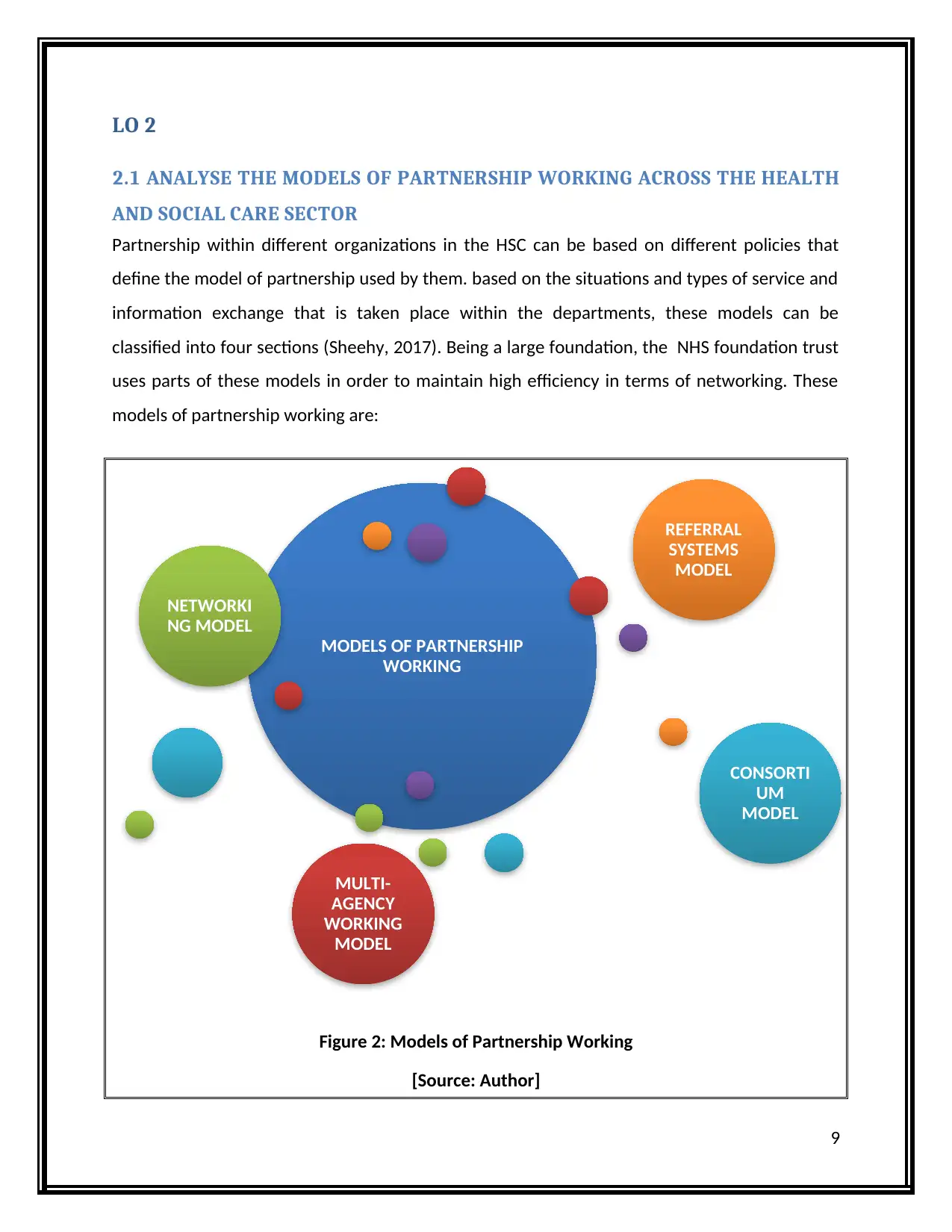
LO 2
2.1 ANALYSE THE MODELS OF PARTNERSHIP WORKING ACROSS THE HEALTH
AND SOCIAL CARE SECTOR
Partnership within different organizations in the HSC can be based on different policies that
define the model of partnership used by them. based on the situations and types of service and
information exchange that is taken place within the departments, these models can be
classified into four sections (Sheehy, 2017). Being a large foundation, the NHS foundation trust
uses parts of these models in order to maintain high efficiency in terms of networking. These
models of partnership working are:
Figure 2: Models of Partnership Working
[Source: Author]
9
MODELS OF PARTNERSHIP
WORKING
NETWORKI
NG MODEL
REFERRAL
SYSTEMS
MODEL
CONSORTI
UM
MODEL
MULTI-
AGENCY
WORKING
MODEL
2.1 ANALYSE THE MODELS OF PARTNERSHIP WORKING ACROSS THE HEALTH
AND SOCIAL CARE SECTOR
Partnership within different organizations in the HSC can be based on different policies that
define the model of partnership used by them. based on the situations and types of service and
information exchange that is taken place within the departments, these models can be
classified into four sections (Sheehy, 2017). Being a large foundation, the NHS foundation trust
uses parts of these models in order to maintain high efficiency in terms of networking. These
models of partnership working are:
Figure 2: Models of Partnership Working
[Source: Author]
9
MODELS OF PARTNERSHIP
WORKING
NETWORKI
NG MODEL
REFERRAL
SYSTEMS
MODEL
CONSORTI
UM
MODEL
MULTI-
AGENCY
WORKING
MODEL
Paraphrase This Document
Need a fresh take? Get an instant paraphrase of this document with our AI Paraphraser

NETWORKING MODEL
This is the simplest model that is used by different organizations under the NHS foundation
trust where they cooperate with each other in terms of generating funds, delivering services to
clients and much more without any form of formal commitment. This is beneficial since the
sharing of resources takes place; however, demerit is that there is no form of commitment
between departments (Sheehy, 2017). As a carer at Bluebird care, this type of models are often
used to share services with other care groups within southern NHS foundation trust
REFERRAL SYSTEMS MODEL
It involves inter-organizational referrals, which helps the clients in getting the best services
from well-known organizations. Clients are referred to respected organizations if the services
are not available in that department. As mentioned in the Francis Report, clients used to suffer
from various issues, which may have been solved if they were referred to respected different
organizations. For instance, patients who were unable to eat on their own should have been
transferred to Bluebird care which is known for such services (CQC, 2013). The demerit
associated with this is, organizations improper flow of information and opaqueness within two
can raise the issue for patients.
CONSORTIUM MODEL
In such partnership within the organisation, there is a legal contract between two in terms of
sharing either resources or capital. Mostly, the purpose of this model is to get financial benefit
in biding or other such opportunities. The benefit that cares services like Bluebird gets is that
they can obtain many costly resources combined (Sheehy, 2017); however, the demerit is that
the contract must be rigid and both parties must follow ethical standards.
MULTI-AGENCY WORKING MODEL
Partnership in which different organizations shares expertise and resources with each other to
improve their service quality and enhance their experience using such a model. There is a
partnership agreement between two parties; however, a level of trust is required to work
10
This is the simplest model that is used by different organizations under the NHS foundation
trust where they cooperate with each other in terms of generating funds, delivering services to
clients and much more without any form of formal commitment. This is beneficial since the
sharing of resources takes place; however, demerit is that there is no form of commitment
between departments (Sheehy, 2017). As a carer at Bluebird care, this type of models are often
used to share services with other care groups within southern NHS foundation trust
REFERRAL SYSTEMS MODEL
It involves inter-organizational referrals, which helps the clients in getting the best services
from well-known organizations. Clients are referred to respected organizations if the services
are not available in that department. As mentioned in the Francis Report, clients used to suffer
from various issues, which may have been solved if they were referred to respected different
organizations. For instance, patients who were unable to eat on their own should have been
transferred to Bluebird care which is known for such services (CQC, 2013). The demerit
associated with this is, organizations improper flow of information and opaqueness within two
can raise the issue for patients.
CONSORTIUM MODEL
In such partnership within the organisation, there is a legal contract between two in terms of
sharing either resources or capital. Mostly, the purpose of this model is to get financial benefit
in biding or other such opportunities. The benefit that cares services like Bluebird gets is that
they can obtain many costly resources combined (Sheehy, 2017); however, the demerit is that
the contract must be rigid and both parties must follow ethical standards.
MULTI-AGENCY WORKING MODEL
Partnership in which different organizations shares expertise and resources with each other to
improve their service quality and enhance their experience using such a model. There is a
partnership agreement between two parties; however, a level of trust is required to work
10
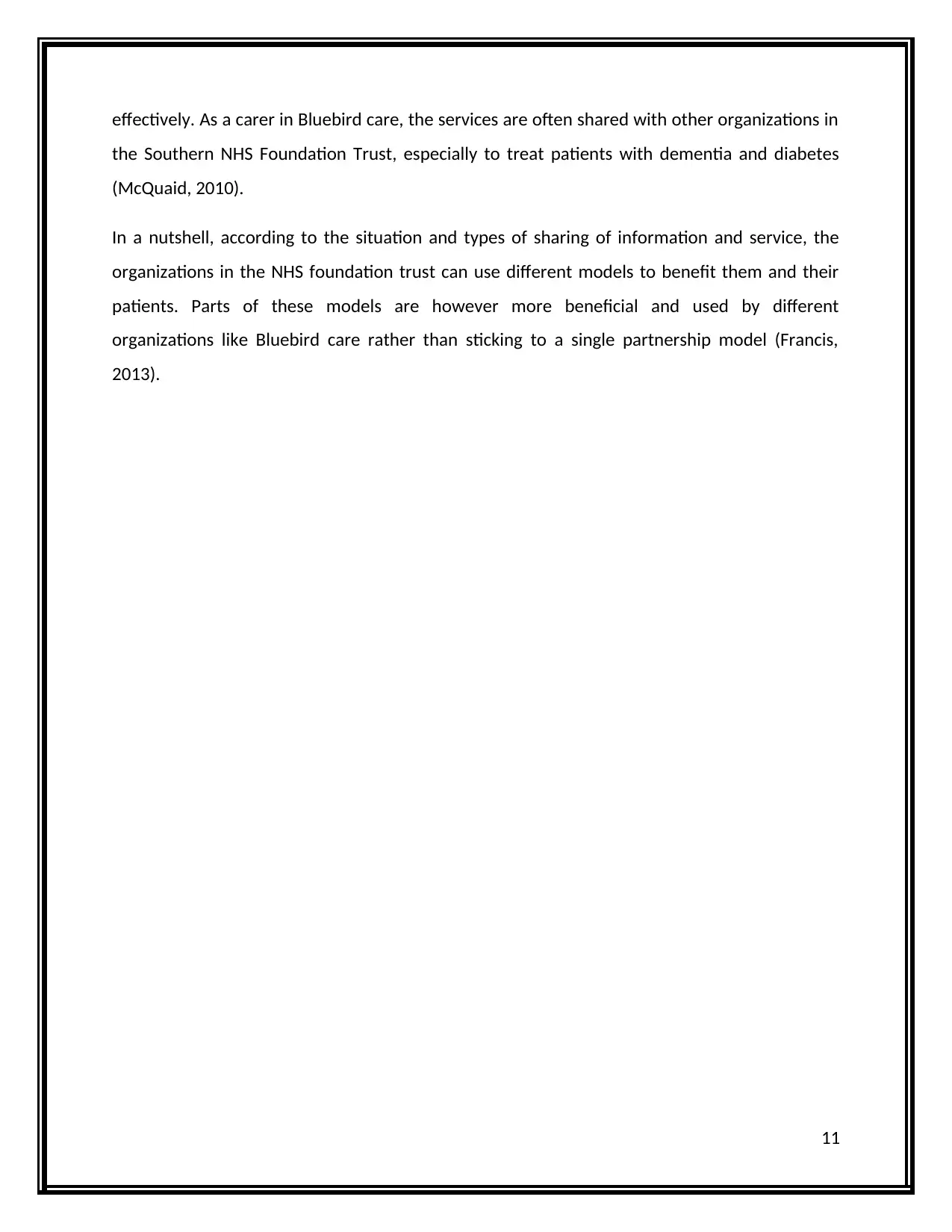
effectively. As a carer in Bluebird care, the services are often shared with other organizations in
the Southern NHS Foundation Trust, especially to treat patients with dementia and diabetes
(McQuaid, 2010).
In a nutshell, according to the situation and types of sharing of information and service, the
organizations in the NHS foundation trust can use different models to benefit them and their
patients. Parts of these models are however more beneficial and used by different
organizations like Bluebird care rather than sticking to a single partnership model (Francis,
2013).
11
the Southern NHS Foundation Trust, especially to treat patients with dementia and diabetes
(McQuaid, 2010).
In a nutshell, according to the situation and types of sharing of information and service, the
organizations in the NHS foundation trust can use different models to benefit them and their
patients. Parts of these models are however more beneficial and used by different
organizations like Bluebird care rather than sticking to a single partnership model (Francis,
2013).
11
⊘ This is a preview!⊘
Do you want full access?
Subscribe today to unlock all pages.

Trusted by 1+ million students worldwide
1 out of 26
Related Documents
Your All-in-One AI-Powered Toolkit for Academic Success.
+13062052269
info@desklib.com
Available 24*7 on WhatsApp / Email
![[object Object]](/_next/static/media/star-bottom.7253800d.svg)
Unlock your academic potential
Copyright © 2020–2025 A2Z Services. All Rights Reserved. Developed and managed by ZUCOL.





